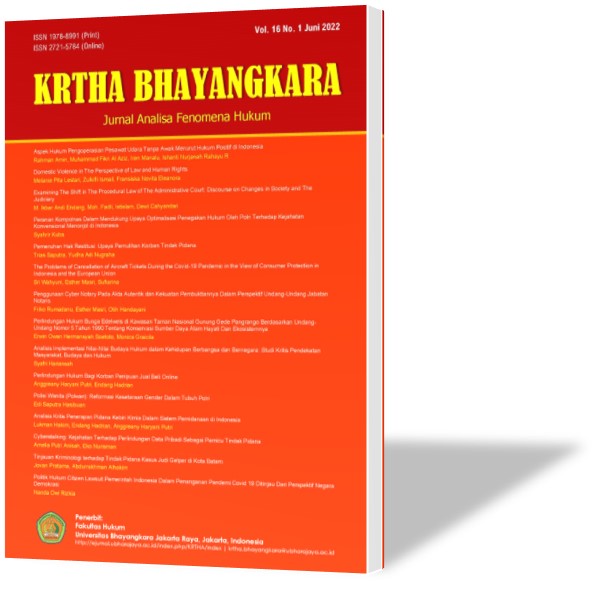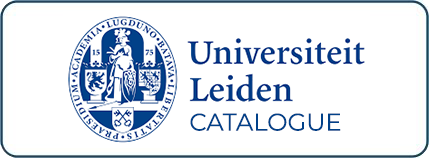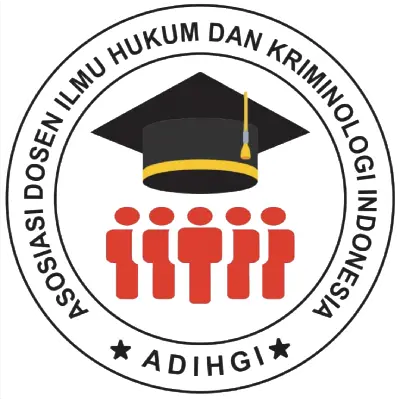Formulation of Underage Marriage in The Perspective of Islamic Law and Legal Sociology
DOI:
https://doi.org/10.31599/krtha.v17i3.795Abstract
The child's independence in pursuing ideals and realizing success for the future is a desire for parents and the country. This can be achieved when the child has carried out a good learning process that can be taken through the formal or informal level. However, the irony that occurs if a child's dream of becoming a person is useful for the future, religion, and the state must be cut off with what happens, such as marriages that are still not on time or underage marriages. This research aims to analyze underage marriages from the perspective of Islamic law and understand the benchmarks of legal awareness in society to minimize the occurrence of underage marriages and to know the implications of underage marriages. This study is library research using a qualitative approach. The results show that Marriage is a strong bond or mitsqon golidhon carried out by couples who have met the age limit or baligh, but marriages, carried out by someone who is underage must be based on a recommendation through a marriage dispensation issued by a religious court. Second, community indicators in realizing legal knowledge and understanding will form a stable legal attitude so that they can apply patterns of legal behavior. Third, the implications of underage marriage include the disruption of compulsory education, Fulfillment of subsistence, which is not optimal for the families, diversion of responsibility to parents because they have not been able to work properly, Reproductive health conditions are still vulnerable due to lack of good nutrition and give rise to poverty and vulnerability to divorce.
References
Adawiyah, Robiatul, Dian Mukhlisa, Yuliatin, and Devrian Ali Putra. “The Reconstruction of Aisyah’s Marriage Age as a Resolution for Child Marriage Practices Phenomenon.” Al-’Adalah 19, no. 1 (2022).
Adi, Rianto. Metodologi Penelitian Sosial Dan Hukum. Yogyakarta: Yayasan Pustaka Obor Indonesia, 2021.
Ahmad Saebeni, Beni. Sosiologi Hukum. Bandung: CV. Pustaka Setia, 2013.
Ahmad, Shieva Nur Azizah, Ali Mubin, Ulil Albab, and Melyana Willy Saputri. “Resiko Pernikahan Dini Dari Sudut Pandang Kesehatan, Hukum, Dan Agama.” Community Services Social Work Bulletin 2, no. 2 (2022).
Amarun, Kahar, and Hadi Suprianto. “Penyuluhan Hukum Pencegahan Perkawinan Usia Dini Pada Siswa-Siswa SMA Negeri 3 Buton Selatan.” SWARNA: Jurnal Pengabdian Kepada Masyarakat 2, no. 1 (2023): 157–162.
Amran, Suadi. Sosiologi Hukum, Penegakan, Realitas, Dan Nilai Moralitas Hukum. Jakarta: Prenada Media, 2018.
Gussevi, Sofia. “Sosialisasi Dan Pendampingan Faktor Penyebab Dan Dampak Perkawinan Di Bawah Umur Serta Undang-Undang Nomor 16 Tahun 2019 Tentang Batas Usia Perkawinan.” SIVITAS 3, no. 1 (2023).
Hanafi, Yusuf. Kontrofersi Perkawinan Di Bawah Umur (Child Marriage) Perspektif Fikih Islam, HAM Internasional, Dan UU Nasional. Bandung: CV. Mandar Maju, 2011.
Hatta, Mohammad. “Batasan Usia Perkawinan Dalam Perspektif Ulama Klasik Dan Kontemporer.” Al-Qanun 19, no. 1 (2016).
Jackson, E.K. “Addressing the Inconsistency Between Statutory Rape Laws and Underage Marriage: Abolishing Early Marriage and Removing the Spousal Exemption to Statutory Rape.” UMKCL 8, no. 5 (2016).
Kathsir, Ibnu. Tafsil Al-Qur’an Al-’Azim. Mesir: Dar al Kutub, n.d.
Keagamaan, Badan Litbang dan Diklat Puslitbang Kehidupan. Menelusuri Makna Di Balik Fenomena Perkawinan Di Bawah Umur Dan Perkawinan Tidak Tercatat. Kustini. Jakarta: Kementerian Agama Republik Indonesia, 2013.
Maulana Munandar, Imam. “Faktor-Faktor Penyebab Terjadinya Pernikahan Dini Di Kota Medan.” Al-Mashlahah: Jurnal Hukum Islam dan Pranata Sosial Islam, no. Special Issue (2022).
Muchtar, Kamal. Asas-Asas Hukum Islam Tentang Perkawinan. Jakarta: Bulan Bintang, 1993.
PPPA, Publikasi dan Media Kementerian. “Menteri PPPA: Perkawinan Anak Harus Dihentikan!” Kementerian PPPA. Last modified 2020. https://www.kemenpppa.go.id/index.php/page/read/29/2822/menteri-pppa-perkawinan-anak-harus-dihentikan.
Putri, F.R.A. “When Girl Become Wives: The Potrait of Underage Marriage in Indonesia.” The Indonesian Journal of International Clinical Legal Education 2, no. 4 (2020): 463–480.
Rahmawati, Lilis, and Any Ismayawati. “Implementasi Undang-Undang Perlindungan Anak Terhadap Perkawinan Di Bawah Umur Akibat Kawin Hamil Di Luar Nikah.” In International Collaboration Conference on Law Sharia and Society (ICCOLaSS). Kudus: IAIN Kudus, 2022.
Rasyid Ridha, Muhammad. Tafsir Al-Qur’an Al-Hakim. Beirut: Dar al Kutub al Imiyyah, 1999.
Saifullah. Refleksi Sosiologi Hukum. Bandung: PT. Refika Aditama, 2013.
Sari, Okfita. “Analisis Sosiologi Hukum Terhadap Pernikahan Di Bawah Umur Dalam Keluarga (Studi Kasus Masyarakat Desa Purworejo Kecamatan Geger Kabupaten Madiun).” IAIN Ponorogo, 2018.
Sirin, K. Perkawinan Di Bawah Umur. Jakarta: Ghalia Indonesia, 1999.
Soekanto, Soerjono. Pokok-Pokok Sosiologi Hukum. Jakarta: Rajawali Pers, 2012.
Tholabi Kharlie, Ahmad. “Kesadaran Hukum Masyarakat Lebak Banten.” Al-Qolam 25, no. 1 (2008).
Widiadhana, Vicky, and Muh Jufri Ahmad. “Urgensi Pernikahan Anak Di Bawah Umur Ditinjau Dari Perspektif Undang-Undang Perkawinan.” Bureaucracy Journal: Indonesia Journal of Law and Social-Political Governance 3, no. 2 (2023).
Widihartati, S, K Dimyati, A Absori, and A.F Azhari. “Underage Marriage in the Perspective of Women’s Protection.” UNTAG Law Review 1, no. 2 (2017): 38–50.
Zulfiani. “Kajian Hukum Terhadap Perkawinan Anak Di Bawah Umur Menurut Undang-Undang No.1 Tahun 1974.” Jurnal Hukum Samudra Keadilan 12, no. 2 (2017): 211–222.
Downloads
Published
Issue
Section
License
Copyright (c) 2024 Humaeroh, Zakaria Syafei, Nurul Ma’rifah

This work is licensed under a Creative Commons Attribution 4.0 International License.



































